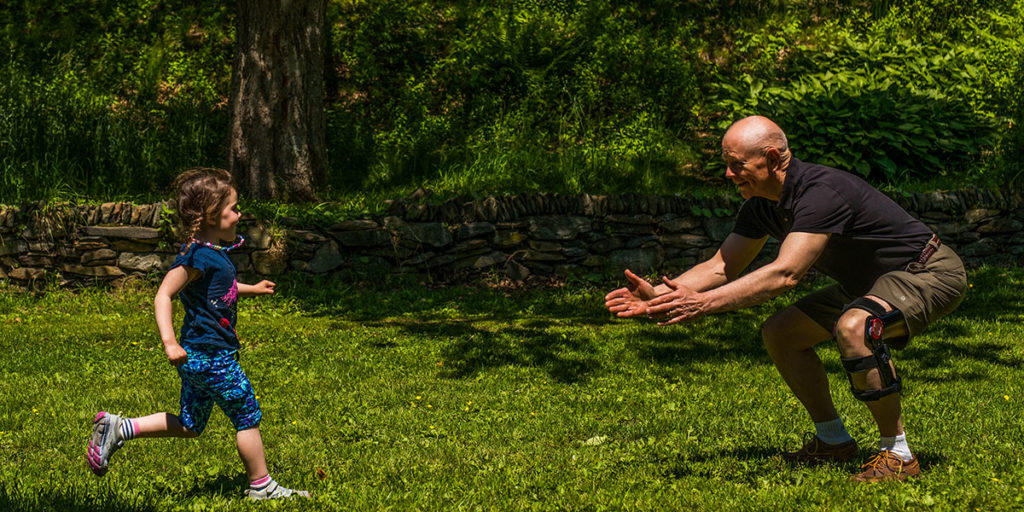After Knee Replacement

Written by Orthopaedic Researcher Matthew Kivell, the following resource is intended to be used as a resource for patients recovering from a knee replacement. Download a copy of this free patient resource.
Phase I
Day of Surgery:
• Use caution
• Rest
• Walk short distances
Post-op Day 2:
• Stand up and walk with assistance
• Work on increasing knee range of motion
Discharge from Hospital:
• Stand up and walk with minimal assistance
Phase II
– (Week 1-3)
Getting Comfortable:
• Walk longer distances and take stairs with assistance
• Continue rehab
Phase III
(Week 4-6)
Increased Function:
• Walk and take stairs with little or no assistance
• Continue rehab
• Regular activities and work resumed
Phase IV
(Week 7-12)
Increased Function:
• Work for longer duration
• Continue exercise and rehab
Phase V
(Months 4-24)
Exercise and Normal Activity:
• Your knee will continue to heal, change and become more comfortable for the next 2 years
Hospital Stay1,2
• You and your team of doctors will determine exactly how long you need to stay in hospital.
• You will begin walking, often the day of the surgery, with the use of a walker, brace, or crutches.
Questions to Ask your Doctor4,6
• How much walking can I do?
• What are the signs that something is wrong with my new knee?
• What are things I cannot do?
• How do I take care of my surgical wound?
• What medications do I take at home?
• Can I take a shower?
• How can I get my home ready?
• When can I go back to see my dentist?
Pain Management1,2,5
Pain management is an important part of your recovery. The following approaches can help:
• Doctor-prescribed oral medication
• Physical therapy
• Assistive knee braces
Bruising1,2,5
Bruising may last for up to 2 weeks. Bruising is often normal, but consult your surgeon if you have concerns. To help reduce bruising, try elevating your leg with a pillow.
Swelling1,2,5
Swelling may be present for as long as 6 months post-surgery. The following approaches can help:
• Post-op exercises
• Leg elevation
• Physical therapy
Next Steps1,6
The success of your surgery depends heavily on what you do once you go home.
• Over time you will return to a regular level of activity.
• It is important to reduce the impact on your knee joint. Some activities involve higher impact than others, for example: downhill skiing, soccer, basketball, and repetitive lifting or squatting.
• Low impact activities such as hiking, gardening, swimming, tennis and golf are encouraged.
• The use of an assistive knee brace may help to reduce joint impact and pain.
Home Set-Up Tips
Becoming aware of possible hazards in your home can make your recovery easier and safer.
• Rearrange furniture to make moving around the house easier.
• Remove throw rugs that could cause you to slip or trip.
• You may want to temporarily rearrange rooms to avoid using the stairs (e.g., make the living room the bedroom).
• Bathroom: Install a shower chair, grip bar and a raised toilet seat.
• Sit in a proper chair that is firm, doesn’t sit too low and has a footstool for leg elevation.
Keeping Your Knee Healthy
Follow your doctors advice to ensure a successful recovery
• Walk regularly and continue to do your recommended exercises every day.
• Avoid activities that could cause a fall.
• Try to minimize stress on your knee throughout the day.
• Use an aid or brace to keep weight off your healing knee.
• Advise your dentist of your knee surgery – antibiotics may be necessary to prevent infection.
• Contact your surgeon or family doctor at any time if you have concerns.
Additional Online Resources
American Academy of Orthopaedic Surgeons: www.aaos.org
The Arthritis Foundation: www.arthritis.org
References
1. AskMayoExpert. (2015). Knee replacement. Rochester, Minn.: Mayo Foundation for Medical Education and Research.
2. American Academy of Orthopaedic Surgeons. (2015). Total Knee Replacement.
3. Greengard, S. (2012). Total Knee Replacement Recovery and Rehabilitation Timeline Infographic. In: Krucik, G.
4. Groomes, T. (2015). Total knee replacement. In: Frontera, W., Silver, J., Rizzo T., eds. Essentials of Physical Medicine and Rehabilitation. 3rd ed. Philadelphia, PA: Elsevier Saunders; chap 80.
5. Martin, G. M. (2016). Total knee replacement (arthroplasty). Retrieved August 4, 2016, from http://www.uptodate.com/contents/total-knee-replacement-arthroplasty-beyond-the-basics?view=print
6. Vital M. (2014). Joint Replacement Surgery: Health Information Basics for You and Your Family. National Institute of Arthritis and Musculoskeletal and Skin Disease